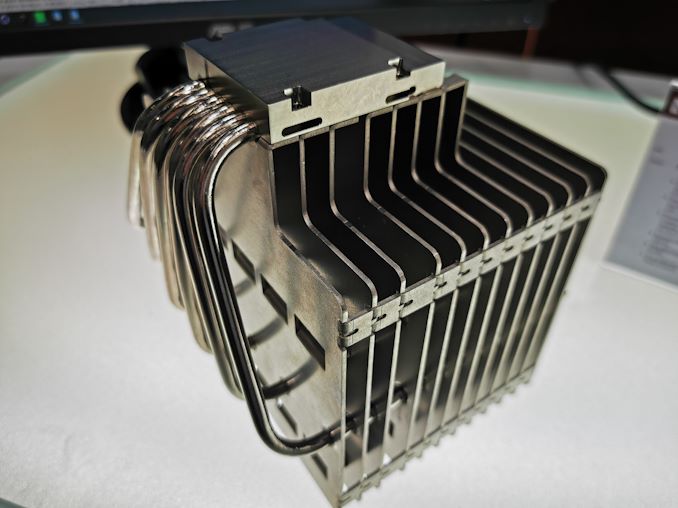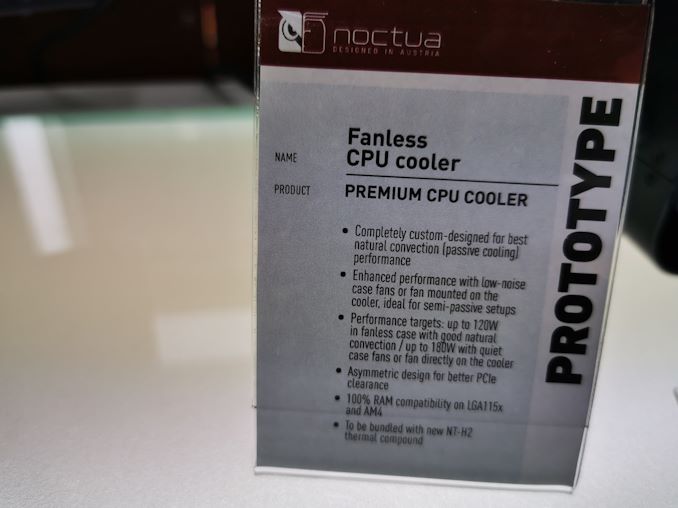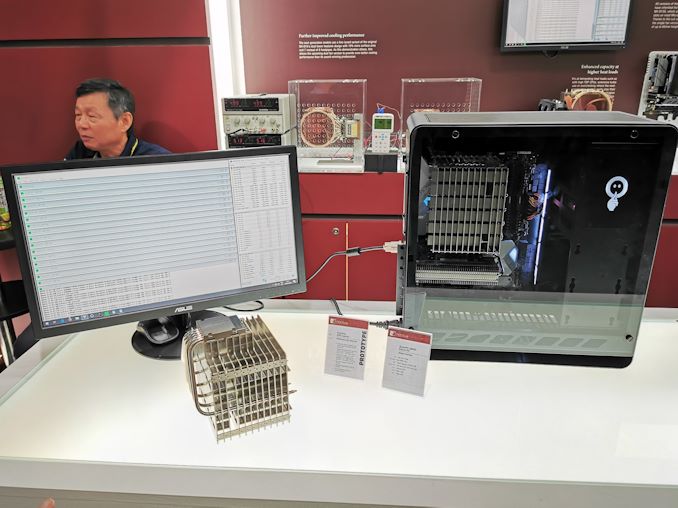Noctua Concept Fanless CPU Cooler: Up to 120W Of Cooling Performance
by Gavin Bonshor on June 6, 2019 8:00 AM EST
Noctua might have had a small booth showing off its products at Computex, but it had plenty to show for itself. On the booth was a new and conceptual design with a large aluminum tower heat sink weighing around 1.5 kg. This means processors drawing up to 120 W can be used while eliminating noise levels to zero.
Well known for its high-end air CPU cooling solutions and unique color theme, Noctua has designed a completely fanless CPU cooler with the capacity to handle CPU loads of up to 120 W. After speaking to Noctua about this concept design, they stated that the 120 W is guaranteed with this design providing the chassis has adequate convection, and plenty of breathing room. In tighter environments, the concept can stretch to 180 W with quiet chassis fans, or a fan directly placed onto the cooler. The bulk is made up of aluminum, with an asymmetrical design designed for better PCIe slot clearance, as well as being compatible with memorty on both Intel's LGA115X and AMD's AM4 chipsets.
On the booth was a test system demonstrating the concept, which currently has no name, while it was cooling an Intel Core i9-9900K on an ASUS Prime Z390-A motherboard running Prime95, inside a Jonsbo UM4 chassis. While the temperatures weren't exactly helped on by a warm Taiwanese climate, the Noctua fanless averaged a CPU core temperature of around 94 °C under a full Prime 95 load running all day. That's quite impressive given the Core i9-9900K is a premium processor, although the high temperature did thermally throttle the processor down.
While the Noctua Fanless CPU cooler is still completely conceptual, it's due to be completed and released some time in 2020.
| Want to keep up to date with all of our Computex 2019 Coverage? | ||||||
 Laptops |
 Hardware |
 Chips |
||||
| Follow AnandTech's breaking news here! | ||||||


















35 Comments
View All Comments
azazel1024 - Friday, June 7, 2019 - link
At 1atm and Earth normal composition, you lose about 30% or so of heat through radiation and the rest through conduction and convection. That is why spacesuits have to have liquid cooling systems. For spacewalks, back to the ship if tethered. For non-tethered use in space or on an airless body (like the moon), they use an ice/evaporative cooling system to chill a liquid cooler built in to the suit backpack. EVA's are usually not limited by Oxygen/CO2, but by how much refrigerant can be carried along. That said, operating in shadow/at night it might be a limitation on Oxygen/CO2. Even with the low emissivity of the space suits, you are still picking up something like 100-200 watts of heat IIRC per square meter of insolation and only shedding a dozen or so per square meter that is in shadow. If you were operating entirely in shadow, you'd still have to deal with the metabolic heat generated by the astronaut, which isn't shed quickly enough by radiation from the space suit or the possible limited conduction through whatever part of the astronaut is touching something (okay, maybe if you laid down you could cool off faster than warm yourself metabolically. But there is also a fair amount of insulation in the suit).To your supposition, if the inside of the case is not in vacuum, the electronics will still be shedding heat through conduction and convection (well and radiation). The issue is the heat would be shed through conduction, convection and radiation of the case itself. Most cases don't have a whole lot of surface area and often aren't made of materials that conduct or convect heat very rapidly. A (somewhat) open case design is transferring heat inside, to air that is then moved out of the case and replenished from room air that is cooler. Rinse and repeat. The fans moving the air greatly increase the rate of convection. If your electronic were mounted in such a way to increase conduction to the case body and the case body were either constructed of high K materials like Aluminum to help shed heat, and possibly with a surface designed to increase surface area, you could do that. There are a couple of sealed case designed out there like that. Heck, that is how most phones and tablets are constructed.
Valantar - Thursday, June 6, 2019 - link
Now, I'm by no means an audio engineer or know anything about the physical properties of sound waves, but what I've always read is that adding a second sound source at the same sound pressure level at roughly the same distance from the listener doubles the sound pressure level - i.e. a 3dBA increase. I.e. a second 30dBA fan next to one already there increases the noise level to 33dBA. As I said, I don't actually know if this is correct, but it makes sense logically given that you're putting twice the energy into pressure changes in the air - this must affect _something_, unless the pressure changes are cancelling each other out. This is of course not perceived as a doubling in noise given that our hearing doesn't work linearly, so a 1% _perceived_ increase is probably not far off. Then again, the noise floor of most living spaces is somewhere around 30-ish dBA, so adding the first fan might not be noticeable at all, depending on its location, the direction of airflow, the design of the case vents, and so on.Other than that, there are fanless GPUs out there - quite a few. None in the high end, of course, but heck, there's even one in the pictured case! Lots of GTX 1050s and 1050Tis, probably 1650s on the way.
Metroid - Thursday, June 6, 2019 - link
here in my house I have many servers and all of the fans are around 30 db, have hundreds of them, when i add a 40db or even a 50db, the loudest sound comes from the the 40db if x 30db, or 50db x 30db or 40db x 50db, so the loudest will be heard very easily, the other hundreds 30db will be heard too but will have no impact like a 40db or 50db and if I distant myself from the room, i will hear only the loudest sound. My test was, add 1 fan 30db, add 10 30db, 31db, add 20 30db 32db, each 10 added 1db.Metroid - Thursday, June 6, 2019 - link
But the interesting thing was that the 40db was heard very easily even with the 100 fans 30db, so i guess 100 30db was around 35db all of themMetroid - Thursday, June 6, 2019 - link
This article explains much better than I did."Adding Sounds or Noises together on the Decibel Scale
In real life, several sources of sounds often occur at the same time. One may be interested to know what results when one sound is combined with another, i.e. the addition of sounds.
Adding 60 apples to 60 apples results in 120 apples. But this is not the case with sounds when they are expressed in decibels. In fact, adding 60 decibels to 60 decibels gives 63 decibels. The following formula explains the general principle of adding sounds on the decibel scale. Please click on the demo button to see the details.
One can use the above formula to add three sounds together - 60 dB, 65 dB and 70 dB. Please click on the demo button to learn how to use the formula to add the three sounds together.
"
https://www.epd.gov.hk/epd/noise_education/web/ENG...
Daeros - Thursday, June 6, 2019 - link
3bd louder takes twice the power to produce, but is *just* noticeable. 10db sounds twice as loud.Metroid - Thursday, June 6, 2019 - link
In the example above is 2% if you add a second but a third and the next so no will reduce and reduce, in the end like my case 100's fans at 30db, sounds 35db.Metroid - Thursday, June 6, 2019 - link
Here is another important hing to consider."Although the ear can distinguish the rise in level between one or two pins dropping, it cannot distinguish between 10,000,000,000,000 pins and 10,000,000,000,001 pins or even 10,100,000,000,000 because it is not a linear device. It can, however, distinguish the significant multiplying of the energy of the sound. When this sound is doubled this is equated to a rise of 3dB (decibels), using a logarithmic scale*. In a work context, this means that a small increase in the number of decibels results in a huge change in the amount of noise and, as such, the potential damage to a person’s hearing. Let’s look at a few examples. If the pin dropping has a sound level of 10dB (decibels) then two pins would have a level of 13dB. 10,000,000,000,000 pins would have a level of 140dB and 20,000,000,000,000 pins a level of 143dB."
https://pulsarinstruments.com/en/post/understandin...
azazel1024 - Friday, June 7, 2019 - link
Actually it would be a volume increase of 3dB if you went from one fan at X noise to two fans each at X noise. You'd have twice the sound level (which is a 3dB increase). So if you went from a case with one fan at 30dB and then upgraded it to have 4 fans at 3dB, you'd end up at 36dB (two doublings of sound pressure, from one to two and then two to four).konbala - Thursday, June 6, 2019 - link
Wonder why there isn't more fanless design like Airtop's, probably it's not easy and it's patented...